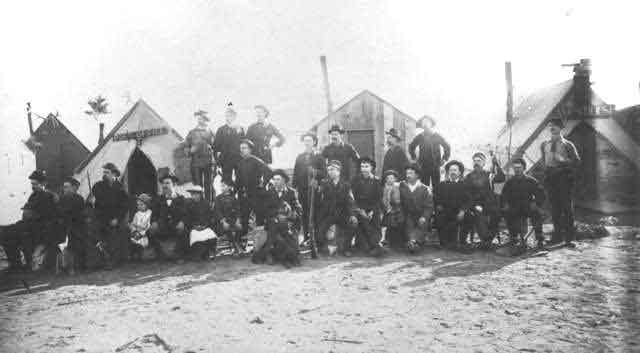Our area's first settlement was known as "Willow" and began at the base of the cliffs on West Willow Creek, near the present day North Creede. The 1890 discovery of a hefty silver deposit at the Holy Moses Mine by Nicholas C. Creede lead to the nearly overnight boom of early Creede. "Creede Camp" consisted of several settlements including Stumptown, Jimtown (present-day Creede), Amethyst, Weaver, Sunnyside, and Bachelor. It enjoyed a short, highly prosperous boom. Popular guesstimates ranged from 6,000 to 10,000 people that flooded in to get their share of the plentiful resources.
Governance of the town began sporadically. Due to the boisterous nature of its boomtown citizens, it was of course, imperative to appoint marshals immediately. A pamphlet printed by the Rocky Mountain News reported that, at this time, "Municipal affairs are regulated by committees appointed by mass meetings of the citizens." There were also sporadic appearances by officials of Saguache, Hinsdale, and Rio Grande Counties, all of which had some claim to the Creede Camp, but none of which volunteered police protection or other government services to the area.
Creede incorporated on June 13, 1892, only 8 days after a great fire burned much of the town to the ground. Its first mayor was Edward Morton. Creede held its first election July 12, 1892 at which Mayor Hurlburt, and Aldermen Long, McConnel, Burns, Gipson, Kelly, and Morrow were elected.
Creede Candle publications following the election reveal a politically turbulent time, rife with corruption, immersed in warring Democratic, Republican, and People’s parties. Political division and frustration is evidenced by multiple complaints, for example, "when people elect a .22-calibre council to govern a .45-calibre city, they must expect to pay for the packing which goes between."
There was also tension between Creede Camp and the owner of Wason Ranch, M.V.B. Wason. Mr. Wason felt that his ranch would be an ideal setting for the main town in the area due to the confluence of roads, waterways, and safety from floods. Most citizens of Creede felt differently, but when Mineral County was incorporated on March 27, 1893, state legislature surprisingly named Wason as the County Seat. The Town Council of Creede took the matter to a vote, and on November 1893, Mineral County voters chose Creede as the county seat. Mr. Wason attempted to delay this move on technicalities, and so, citizens of Creede, when "darkness had barely settled," made way for Wason and hijacked all the town records, docket books, etc. by wagon, deposited them at the Bank and several hotel rooms, and began setting up shop. Thus the matter was settled, and Creede became the County Seat of Mineral County.
After the infamous Silver Crash, Creede came dangerously close to desertion. From then on, Creede has had its ups and downs. Multiple silver panics, bitter cold winters, and a boom-or-bust way of life have threatened to render the settlement on Willow Creek a ghost town many times. Whether it's an indomitable spirit, wild stubbornness, unshakable loyalty, or just plain outright love for these hills, it seems certain that we are here to stay.
Historical information is plentiful in Creede. Stop by the Creede Museum, the Creede Mining Museum, pick up one of the area's many history books, or take the Bachelor Loop Tour.


Miscellaneous fun historical documents:
The History of the Discovery and Early Exploration of the Cliff Houses of the Mesa Verde, Written by CC Mason, Hermit Lakes area homesteader, with approval of the Wetherill Brothers, transcribed by Don C. LaFont, 6/30/1918 - Courtesy of Andy Brink
